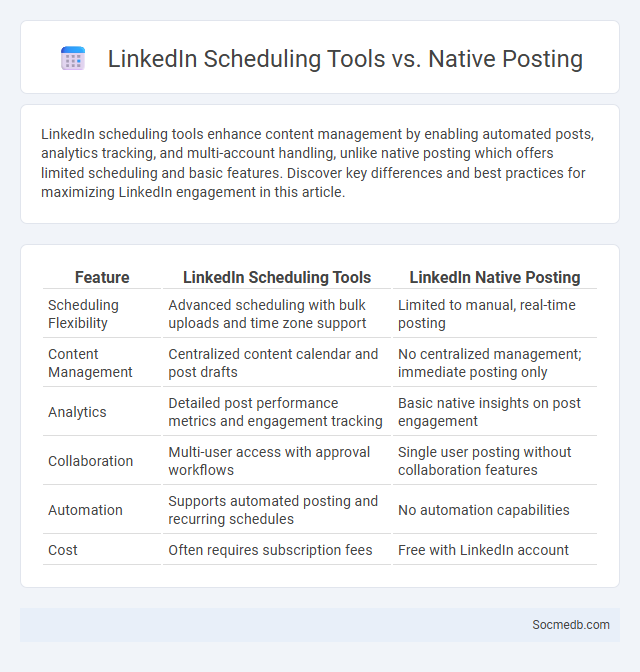
Photo illustration: LinkedIn Scheduling Tools vs Native Posting
LinkedIn scheduling tools enhance content management by enabling automated posts, analytics tracking, and multi-account handling, unlike native posting which offers limited scheduling and basic features. Discover key differences and best practices for maximizing LinkedIn engagement in this article.
Table of Comparison
| Feature | LinkedIn Scheduling Tools | LinkedIn Native Posting |
|---|---|---|
| Scheduling Flexibility | Advanced scheduling with bulk uploads and time zone support | Limited to manual, real-time posting |
| Content Management | Centralized content calendar and post drafts | No centralized management; immediate posting only |
| Analytics | Detailed post performance metrics and engagement tracking | Basic native insights on post engagement |
| Collaboration | Multi-user access with approval workflows | Single user posting without collaboration features |
| Automation | Supports automated posting and recurring schedules | No automation capabilities |
| Cost | Often requires subscription fees | Free with LinkedIn account |
Understanding LinkedIn Scheduling Tools
LinkedIn scheduling tools enable you to plan and automate the timing of your posts, ensuring consistent engagement with your professional network. These tools provide features like content calendars, analytics, and optimal posting time suggestions tailored to LinkedIn's audience. Understanding how to use LinkedIn scheduling tools effectively increases your visibility and helps maintain a strong online presence.
Native Posting on LinkedIn: Features and Limitations
Native posting on LinkedIn allows you to share videos, images, and articles directly within the platform, maximizing engagement through LinkedIn's algorithm favoring content uploaded natively. Features include tagging connections, adding hashtags, and scheduling posts via LinkedIn's Creator Mode, enhancing post visibility and reach within your professional network. Limitations involve restricted customization options compared to third-party tools and the absence of advanced analytics available on dedicated social media management platforms.
Decoding the LinkedIn Feed Ranking Algorithm
LinkedIn's feed ranking algorithm prioritizes content based on personalized relevance, user engagement, and content quality signals such as likes, comments, and shares. The algorithm leverages machine learning models to assess connections' interactions, topical interest alignment, and posting frequency to deliver timely and contextually relevant updates. Optimizing visibility involves creating authentic, engaging posts that encourage meaningful interactions and align with professional networks' interests.
Scheduling Tools vs Native Posting: Engagement Insights
Scheduling tools enable you to plan and automate your social media posts across multiple platforms, increasing consistency and saving time while providing analytics to optimize engagement. Native posting often results in higher real-time interaction due to platform-specific features, such as Stories and Reels, which scheduling tools may not fully support. Balancing the efficiency of scheduling tools with the responsiveness of native posting can maximize your social media engagement insights and overall reach.
Impact of Scheduling Tools on LinkedIn Post Visibility
Scheduling tools significantly enhance LinkedIn post visibility by optimizing posting times based on audience activity data, increasing engagement rates. These tools enable consistent content delivery, which strengthens algorithmic favorability and broadens reach to targeted professional networks. By analyzing performance metrics, scheduling tools allow for strategic adjustments, maximizing impressions and fostering deeper audience interactions on LinkedIn.
Native Posting and Algorithmic Favorability
Native posting on social media platforms involves sharing content directly through the platform's own tools, enhancing visibility by aligning with algorithmic preferences. Algorithms prioritize native content by boosting engagement metrics such as likes, shares, and comments, leading to greater organic reach. Brands leveraging native posts benefit from improved algorithmic favorability, resulting in higher audience interaction and optimized content distribution.
Key Benefits of Using Third-Party Scheduling Tools
Third-party scheduling tools streamline social media management by enabling users to plan and automate posts across multiple platforms, boosting content consistency and audience engagement. These tools offer advanced analytics and performance insights, allowing businesses to optimize posting times and tailor content strategies effectively. Time savings and improved workflow coordination empower marketers to focus on creative tasks and strategic growth initiatives.
Feed Ranking Factors: How Content Distribution Works
Feed ranking factors prioritize content based on user engagement metrics such as likes, comments, shares, and dwell time to enhance relevance in social media algorithms. Content distribution is influenced by personalized algorithms that analyze user behavior, interests, and interactions to deliver tailored feeds that maximize user retention. Platforms continuously update these ranking signals using machine learning models to optimize visibility and promote content that drives active participation.
Best Practices for Maximizing LinkedIn Reach
Posting consistently with high-quality, industry-relevant content increases your visibility on LinkedIn's algorithm and attracts targeted engagement. Optimizing your profile with strategic keywords and participating in relevant groups enhances discoverability, driving traffic to your posts. Engaging authentically with your network by commenting and sharing valuable insights boosts your reach and establishes your authority in your professional niche.
Choosing the Right LinkedIn Posting Strategy
Selecting the optimal LinkedIn posting strategy involves analyzing audience engagement metrics to tailor content types, such as thought leadership articles, industry news, and professional achievements. Prioritize posting during peak activity hours, typically between 8-10 AM and 4-6 PM on weekdays, to maximize visibility and interaction. Leveraging LinkedIn's native features like polls, videos, and LinkedIn Live enhances organic reach and builds a stronger professional network.
 socmedb.com
socmedb.com